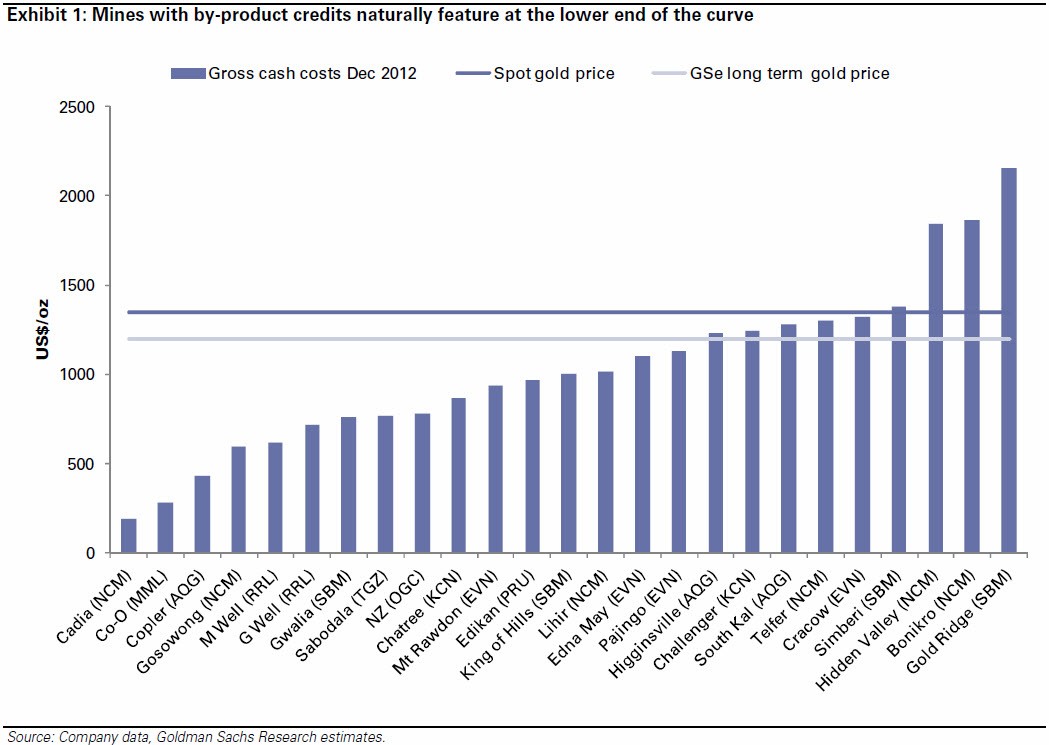Canadian Gold Mining Company Average Gold Ore Value Chart
Post on: 7 Апрель, 2015 No Comment

Correlation Between Average Ore Value per Tonne and Enterprise Value per Ounce of Gold Equivalent
GoldMinerPulse has been tracking fundamental metrics of the TSX/TSXv gold and silver miners for the past 5 years. The fundamental data tells a story about the gold and silver producers — the main theme I have observed is that there is a high correlation between the average ore value of a producer’s mines and the market assigned enterprise value per ounce of gold equivalent for that producer.
On an intuitive level, the relationship between ore value and enterprise valuation per ounce is expected since the costs to extract, move, crush and process a tonne of ore is, in a first order approximation, independent of the metal content of the rock. More metal in a tonne of rock equals better potential for profits.
A sample of 12 months of data points on a subset of the gold producer majors supports the observation of higher ore value per tonne equals higher enterprise value per ounce of gold equivalent.
Notes
The above chart showing two metrics, Average Ore Value per Tonne versus Enterprise value per ounce of Gold Equivalent (total resources) over 12 month end snapshots, using a log scale on the x and y axis.
All data presented was collected from documents filed on Sedar.com, end of day spot metal quotes and closing stock prices. All data points reflect what information was released prior to the TSX market close on the last trading day of each month. Data disclosures made after the market close are included in the next month end update. Please see Charts Demo for more details on charts GoldMinerPulse provides.
When the complete set of TSX/TSXv gold and silver miners are considered:
using an enterprise value weighting on sample points (e.g. a Barricks is given much higher weight than a small producer),
considering total resource (Proven+Probable plus Measured+Indicated plus Inferred),
excluding any producers that had more than x zero volume days in the last 100 trading days, and
adjusting for outliers (outliers occur for many factors, including mining friendly history of the country hosting the mine, ratio of resources from projects in production versus resources from projects that are still preproduction and which there for have likelyhood of future development costs as well as higher risks if the projects are prefeasibility, and finally project size and operating history).
the linear correction computed using Statistics-LineFit has over the last 6 months of daily computations:

Sigma ranging between 25 to 30 — Sigma is an estimate of the homoscedastic standard deviation of the error, also known as the standard error of the estimate.
R squared ranging between 0.63 and 0.7+ — R squared, also called the square of the Pearson product-moment correlation coefficient, is a measure of goodness-of-fit.
Please e-mail dennis@goldminerpulse.com to request a copy of the daily sigma and R Squared values computed daily over a six month period.
Conclusion. the correlation numbers tell the story on how to look at TSX/TSXv gold and silver producers.
A naive interpretation of the ore value and enterprise value per ounce correlation might be to assume a higher average ore value is a better investment choice. That conclusion would be wrong. A high average ore value does not immediately imply best value.
To leverage the excellent correlation between the average ore value and enterprise value per ounce of gold equivalent, into actionable information, GoldMinerPulse is introducing a Relative Strenght Estimate (RSE) computed metric. The computational details of the RSE metric are strictly confidential, however, I will be publishing the TSX/TSXv gold/silver producer composite RSE metric (computed from the per producer RSEs) on the home page starting in October, 2014 — the RSE numbers will speak for themselves and I believe you will agree that the RSE average for all the TSX/TSXv gold/silver producers is a useful indicator for estimating gold market trend direction. And as the data on the Returns From Gold Equity ETFs vs Gold/Silver Bullion vs Stock Picking the TSX Producers shows, in a market where the price of gold is rising you want exposure to an ETF like the GDXJ (or comparable stock picks) to realize maximum returns. Alternatively when the gold market is falling, cash is the best choice. If your investment plan requires a constant exposure to the gold sector, then gold bullion (or a gold bullion ETF) would be the best choice in the falling gold market as that choice will minimize your losses. Watch the day to day rotation of leaders and losers in the Returns From Gold Equity ETFs vs Gold/Silver Bullion vs Stock Picking the TSX Producers on the home for proof.
I also believe you will agree that the per producer RSE metric is a useful metric for making trade decisions on individual gold/silver producers. The per producer RSE metric will be available on a monthly subscription basis starting in Q4, 2014. Please contact dennis@goldminerpulse.com for more information or the RSE subscription or any related questions.














